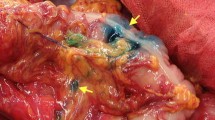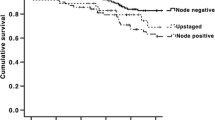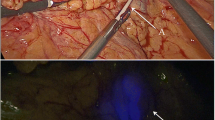Abstract
Background
Carbon dye, when peritumourally injected, permanently marks the drainage site of sentinel lymph nodes (SLN). The objective of the current study was to evaluate whether the use of carbon dye facilitated the detection of small nodal tumour infiltrates in colon cancer patients.
Methods
In a prospective trial, 19 patients underwent open, oncological resections of localized colon cancer and SLN procedure according to a standardized protocol. Isosulfan blue 1% and sterile filtered carbon dye (mixed 1:1) were injected into the subserosa circumferentially around the tumour. Lymph nodes staining blue were marked as SLN. Serial sections of each SLN were stained with hematoxylin and eosin (H&E) and with the pancytokeratin marker AE1/AE3. The intranodal presence and site of carbon particles were noted and compared with the location of possible tumour infiltrates.
Results
Identification of at least one SLN was successful in 18 patients (identification rate 95%). Four patients (22%) were pN+, 11 (61%) were pN0(i−). Three patients (17%) were upstaged from pN0(i−) to pN0(i+) as isolated tumour cells were detected in their SLN: in two (11%) of the three patients, carbon dye and isolated tumour cells were found in the same nodal compartment, hence facilitating the recognition of isolated tumour cells by the pathologist.
Conclusion
The use of carbon dye in the SLN procedure for colon cancer may facilitate the detection of small nodal tumour infiltrates.

Similar content being viewed by others
References
Greenson JK, Isenhart CE, Rice R, et al. Identification of occult micrometastases in pericolic lymph nodes of Duke’s B colorectal cancer patients using monoclonal antibodies against cytokeratin and CC49. Correlation with long-term survival. Cancer 1994;73:563–569
Liefers GJ, Cleton-Jansen AM, van de Velde CJ, et al. Micrometastases and survival in stage II colorectal cancer. N Engl J Med 1998;339:223–228
Saha S, Bilchik A, Wiese D, et al. Ultrastaging of colorectal cancer by sentinel lymph node mapping technique – a multicenter trial. Ann Surg Oncol 2001;8:94S–98S
Haigh PI, Lucci A, Turner RR, et al. Carbon dye histologically confirms the identity of sentinel lymph nodes in cutaneous melanoma. Cancer 2001;92:535–541
Morton DL, Hoon DS, Cochran AJ, et al. Lymphatic mapping and sentinel lymphadenectomy for early-stage melanoma: therapeutic utility and implications of nodal microanatomy and molecular staging for improving the accuracy of detection of nodal micrometastases. Ann Surg 2003;238:538–549
Viehl CT, Hamel CT, Marti WR, et al. Identification of sentinel lymph nodes in colon cancer depends on the amount of dye injected relative to tumor size. World J Surg 2003;27:1285–1290
Sobin LH, Wittekind C. TNM Classification of malignant tumours. 6th edn. Wiley, New York, 2002
Morton DL, Wen DR, Wong JH, et al. Technical details of intraoperative lymphatic mapping for early stage melanoma. Arch Surg 1992;127:392–399
Giuliano AE, Kirgan DM, Guenther JM, et al. Lymphatic mapping and sentinel lymphadenectomy for breast cancer. Ann Surg 1994;220:391–398
Giuliano AE, Dale PS, Turner RR, et al. Improved axillary staging of breast cancer with sentinel lymphadenectomy. Ann Surg 1995;222:394–399
Joosten JJ, Strobbe LJ, Wauters CA, et al. Intraoperative lymphatic mapping and the sentinel node concept in colorectal carcinoma. Br J Surg 1999;86:482–486
Saha S, Wiese D, Badin J, et al. Technical details of sentinel lymph node mapping in colorectal cancer and its impact on staging. Ann Surg Oncol 2000;7:120–124
Feezor RJ, Copeland EM III, Hochwald SN. Significance of micrometastases in colorectal cancer. Ann Surg Oncol 2002;9:944–953
Author information
Authors and Affiliations
Corresponding author
Rights and permissions
About this article
Cite this article
Viehl, C.T., Guller, U., Hamel, C.T. et al. Carbon Dye Staining of Sentinel Lymph Nodes Facilitates Microstaging of Colon Cancer Patients. World J. Surg. 30, 453–456 (2006). https://doi.org/10.1007/s00268-005-0336-y
Published:
Issue Date:
DOI: https://doi.org/10.1007/s00268-005-0336-y




